PinotFile: 8.26 November 24, 2010
|
Reach for the Middle for Pinot NoirThe Russian River Valley is a box-shaped region in northern Sonoma County, just fifteen miles on any side, its four corners consisting of the towns of Healdsburg and Guerneville in the North and Sebastopol and Santa Rosa in the South. Of the total of 126,600 acres of rolling hills, dense redwood forests and apple orchards, approximately 15,700 acres are planted to wine grapes. Pinot Noir plantings account for about one-third of this acreage. The defining feature of the Russian River Valley is a single three-letter word: fog. Fog from the Pacific Ocean enters the Russian River Valley through the Russian River from its origins at Jenner on the Sonoma Coast in the more northern aspect of the appellation, and more significantly, from the Southwest through the Petaluma Wind Gap between Pt. Reyes and Bodega Bay toward Sebastopol, which is situated approximately ten miles south of the Russian River. The father north you go in the Russian River Valley appellation, the more the maritime influence wains and the warmer it becomes.
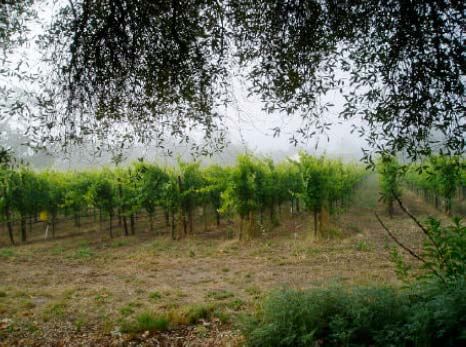 There is plenty of daytime warmth (the Russian River Valley is a Region II on the University of California at Davis Heat Summation Scale) in the Russian River Valley, giving way to cool nights and mornings caused by the wind-borne fog. The result of God’s air conditioning is slowed ripening and extended hang time. The winegrowers in the Russian River Valley like to say that they turn fog into Pinot Noir.
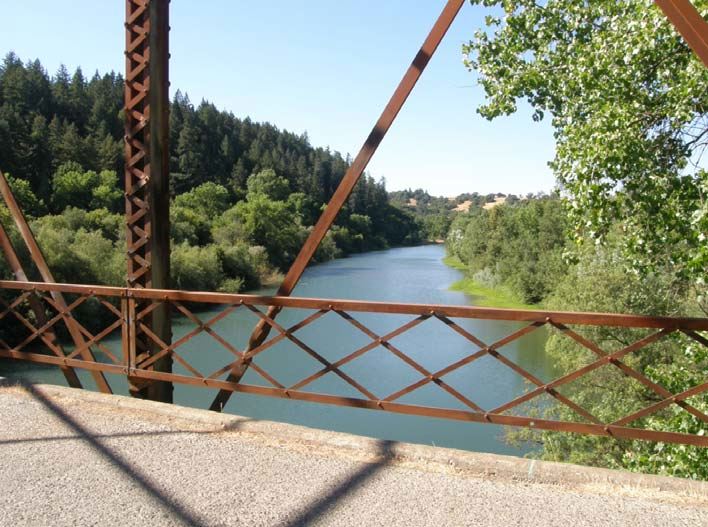
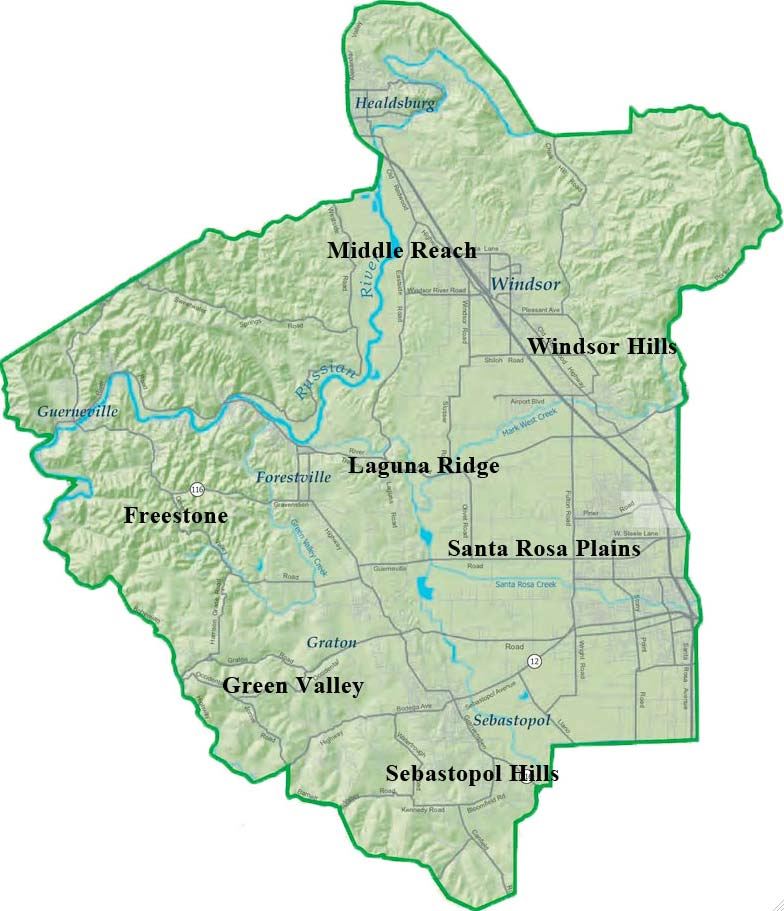 The Middle Reach sub-region is a north-south stretch on either side of the Russian River between Healdsburg and Forestville. The western boundary is roughly marked by Westside Road and the eastern limit by Eastside Road. The southern boundary extends to the Wohler Bridge at the junction of Westside Road and Wohler Road, although some locals extend the sub-region further south on Westside Road to include Moshin, George and Gary Farrell wineries. See map below.
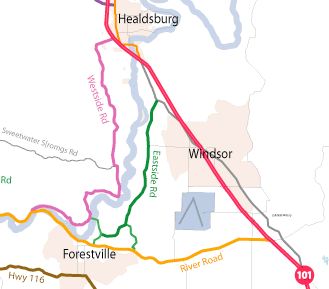 A drive along Westside Road in the Middle Reach can put you in a bucolic trance. The sleepy two-lane winding road has sparse automobile traffic and presents an ever-changing panorama of trees, old barns, vineyards and iconic wineries. It is my favorite stretch of wine country road in California. Heading south out of Healdsburg, the wineries appear one after the other: Alderbrook, Armida, De La Montanya, Twomey Cellars, C. Donatiello, John Tyler (Bacigalupi Vineyard), Hop Kiln, Rochioli Vineyards & Winery, Williams Selyem, Arista, Thomas George Estates, Porter Creek, Moshin Vineyards and Gary Farrell Wines. Other notable Pinot Noir producers in the Middle Reach include Castalia, Copain, Derbes, Desmond Estate Vineyards, EnRoute, Foppiano, Gracianna Vineyards, J Winery & Vineyards, Ketcham Estate, MacMurray Ranch, Matrix Winery, Mueller, Rodney Strong Vineyards, and Sapphire Hill Vineyards & Winery.
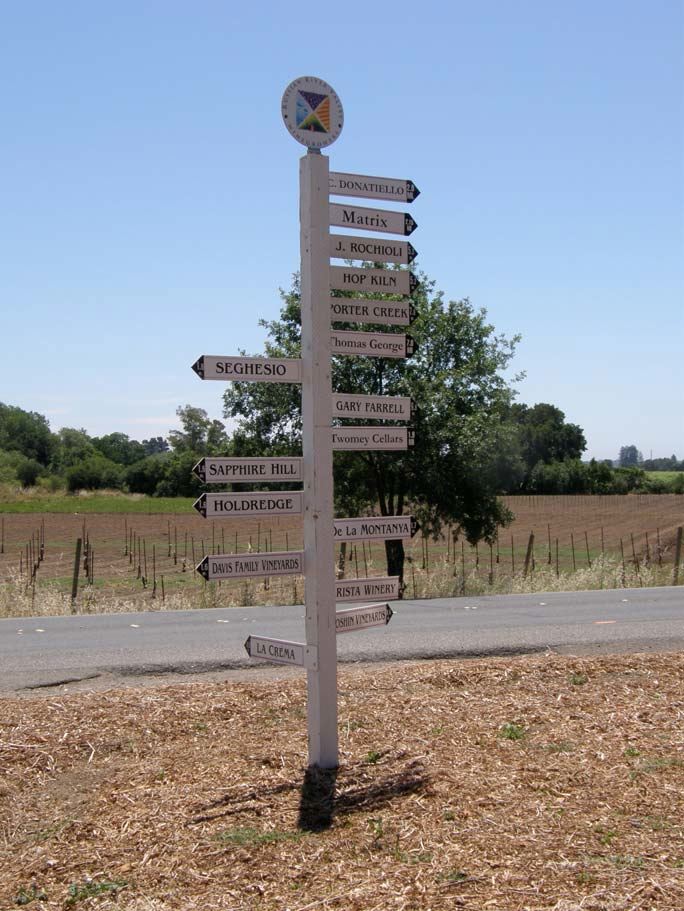 Many producers located outside the Middle Reach source grapes from the many premium vineyards in the sub-region such as Allen, Amber Ridge, Bacigalupi, Buena Tierra, Flax, Floodgate, Koplen, Rochioli, Salzberger/Chan and Widdoes vineyards. The Middle Reach is a relatively warm sub-region because it is inland and more isolated from the maritime effect, particularly in its northern limits where it can be downright hot in the summer. Vineyards are planted primarily on the plains on either side of the Russian River. Soils are alluvial type composed of silt, clay, sand and gravel and thus well-drained. The wines tend to have a high degree of ripeness, with rich, bright, even flashy fruit, with an intense Bing cherry, wild strawberry, cola and spice profile. Alcohols can be generous, tannins tend to be moderate and velvety, and acidity veers to the bright side. In summary, Middle Reach Pinot Noir is hard to say no to. Some representative Middle Reach Pinot Noirs are reviewed below. The words “Middle Reach” do not appear on the front labels, but some wineries include the words on the back label description of the wine to emphasize the prestigious location of the winery or the vineyard where the grapes were sourced. Expect to pay about $60 and up for top-end Middle Reach Pinot Noirs, but many excellent wines from this sub-region of the Russian River Valley can be found for less.
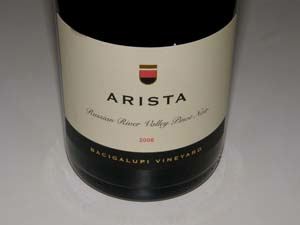 2008 Arista Bacigalupi Vineyard Russian River Valley Pinot Noir 14.4% alc., $56. · Moderately light reddish-purple color in the glass. Demure aromas of spiced Bing cherries picking up more of a savory, leafy bent in the glass over time. Discreet array of medium-weighted dark red Pinot fruit flavors with notes of herbs and mushroom. A relatively simple wine now with impeccably balanced tannins and acidity that is youthful, and will benefit from more development in the bottle. Good.
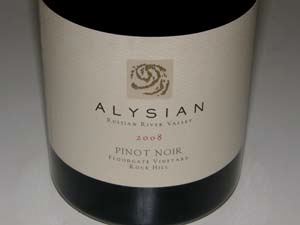 2008 Alysian Rochioli Vineyard River Block Russian River Valley Pinot Noir 14.3% alc., pH 3.46, 233 cases, $65. Pommard, Dijon 115 and 777. 100% de-stemmed. Aged 14 months in 45% new French oak barrels. · A bright and glorious perfume of Bing cherries, wild strawberries and sandalwood. Delicate and crisp flavors of raspberries, cranberries and cherry skins. Smooth and seamless with soft-hewn tannins and a bright kiss of acidity on the uplifting finish. Quintessential Middle Reach.
 2008 Alysian Floodgate Vineyard Rock Hill Russian River Valley Pinot Noir 14.1% alc., pH 3.42, 233 cases, $55. Dijon clone 777. 100% de-stemmed. Aged 13 months in 45% new and 55% one and two-year-old French oak barrels. · Moderately light reddish-purple color in the glass. Brooding aromas of dark fruits and forest floor. Earthy and savory on the palate with shy but charming flavors of plums and boysenberries that sail smoothly and silky to the refreshing finish. Delicately styled but thoroughly satisfying. Not showing everything now. Much better the following day from a previously opened and re-corked bottle offering brighter fruit aromas and flavors. Plenty of pinotosity for the long haul.
2007 Alysian Rochioli Vineyard Allen-Rochioli Blocks Russian River Valley Pinot Noir 14.3% alc., $65. · Welcoming perfume of dark Pinot fruits with hints of mocha and toasty oak. Rich and vivid array of ripe, sweet red and black fruits with an undertone of earth, savory herbs and dark chocolate, nicely framed by fine-grain tannins. This beauty possesses the Rochioli fruit spirit in a more extracted style atypical for a Gary Farrell Pinot. Very good.
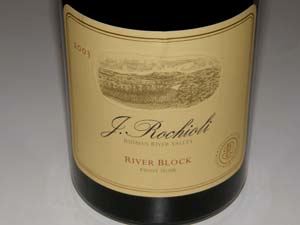 2003 J. Rochioli River Block Russian River Valley Pinot Noir 14.2% alc. · Moderately deep reddish-purple color in the glass. Strong perfume of black cherries with undertones of toasty oak and sawdust. Intense core of black cherry, red plum and strawberry fruit wrapped in substantial tannins with an undertone of anise, charred oak and tar. Fairly muscular but very silky in texture. This Pinot has aged beautifully and will offer several years of future drinking pleasure. Very good.
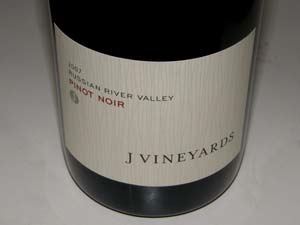 2007 J Vineyards Russian River Valley Pinot Noir 14.3% alc., $35. · Moderate reddish-purple hue in the glass. Alluring aromas of cherries, raspberries and baking spice. Harmoniously woven flavors of berry jam with notes of cherry, plum and cola, all of which persist on the high-toned fruity finish. Harmonious with fine, lacy tannins. About as good as it gets for a Russian River Valley appellation blend and the best from this winery in many years. Very good.
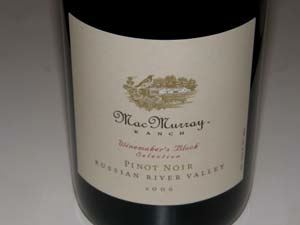 2006 MacMurray Ranch Winemaker’s Block Selection Russian River Valley Pinot Noir 14.5% alc., 400 cases, $60. Clones 37 (Mt. Eden) and Dijon mix. Winemaker Susan Doyle. A little-known and special wine that is the best Pinot Noir in the Gallo lineup of wines. Do not confuse this wine with the high production MacMurray Ranch appellation Pinot Noir bottlings for it is a horse of a different color. · Moderately deep reddishpurple color in the glass. Slightly confected bright and spicy Bing cherry aromas. A charming wine with pleasing delicacy on the palate with its delicious red cherry pie fruit flavor, tasty clove and oak spice, balancing tannins and bright acidity. The persistent finish slips off the back of the palate. Still great two days later from a previously opened and re-corked bottle. This one will make your knees go weak.
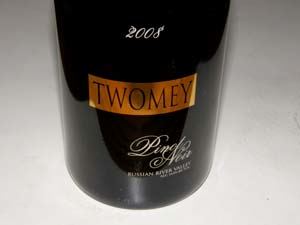 2008 Twomey Russian River Valley Pinot Noir 14.1% alc., $50. Sourced from the Middle Reach. Aged 13 months sur lie in 50% new French oak barrels. · Terrific, well-spiced cherry aroma. Fruit driven with copious black cherry, black raspberry fruit enhanced by flavors of cherry cola and baking spices. Nicely put together with beautifully married oak. A solid choice. Very good.
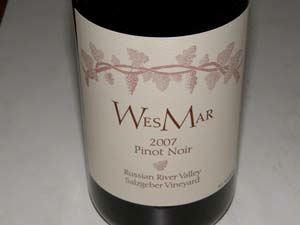 2007 WesMar Salzgerber Vineyard Russian River Valley Pinot Noir 14.4% alc., 129 cases, $45. · Moderate reddish-purple color in the glass. Bing cherry fruit aromas infused with fennel. Tasty core of red cherries and berries accented with flavors of mushrooms and fresh-cut, grassy herbs. Demure and charming in style. Nothing to complain about, but doesn’t excite at this time. Youthful, so wait on this one. Good.
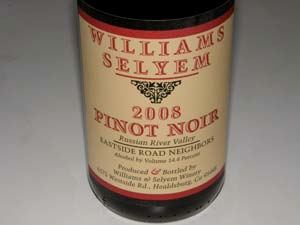 2008 Williams Selyem Eastside Road Neighbors Russian River Valley Pinot Noir 14.4% alc., $49. · Moderate reddish-purple color in the glass. Wonderful aromatics flush with spicy cherries and strawberries. Delicious dark red fruits with nuances of Coca-Cola and spice, lingering on the finish. Very smooth and seductive in the mouth with enough tannic backbone to last. No oak crops up to spoil the party. Very close to the old Williams Selyem style and a wine that speaks Middle Reach loudly.
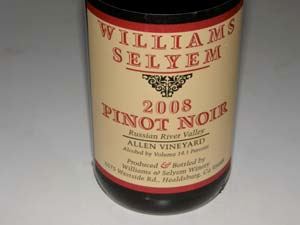 2008 Williams Selyem Allen Vineyard Russian River Valley Pinot Noir 14.1% alc., $78. · Moderately light in reddish-purple hue in the glass. Shy, but very bracing aromas of red cherry and berry fruits with a hint of cut flowers and wintergreen. Flat-out delicious core of strawberry and black cherry cola flavors. Very smooth and sexy with a proper acid backbone to pitch the fruit. A seductive wine now, but needs more time to fully mature. All you can ask for in a Middle Reach Pinot Noir.
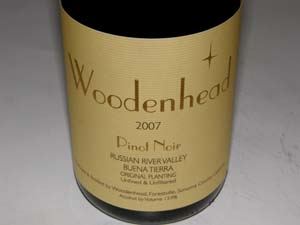 2007 Woodenhead Buena Tierra Vineyard Original Planting Russian River Valley Pinot Noir 13.9% alc., $57. Unfined and unfiltered. · Moderate garnet hue in the glass. On the nose there is a lovely interplay of cherry pie filling, spice, pencil lead and oak char aromas. This Pinot is a delicious cherry bombast nicely spiced with crisp and bright fruit lifted by gleeful acidity that shows up on the finish as a citrus note. Very good.
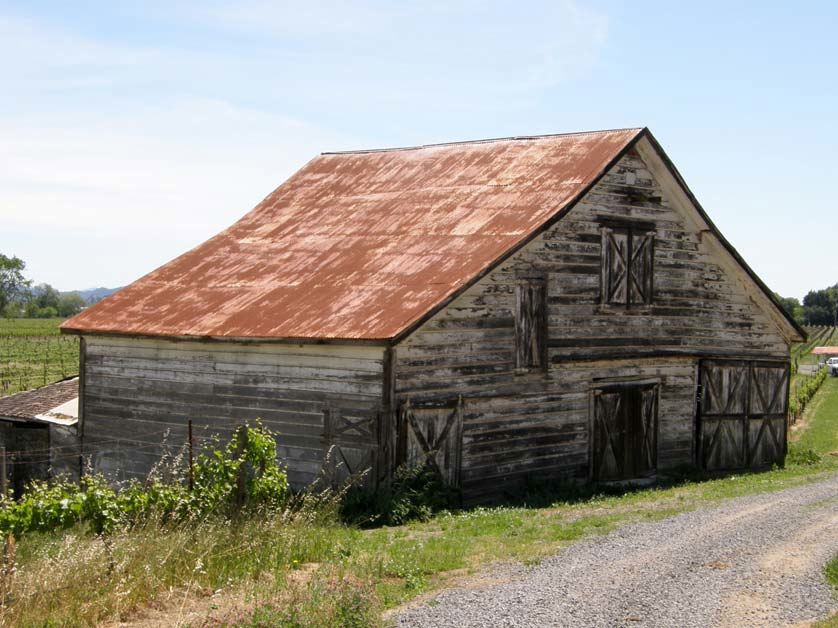
Preview of 2008 Pinots from J Vineyards & WineryJ Vineyards & Winery was established in 1986 and became one of California’s marquee producers of méthode champenoise sparkling wine. J Vintage Brut, J Cuvée 20 Brut, J Late-Disgorged Vintage Brut, and J Brut Rosé have all been highly lauded. The yellow J logo on sparkling wine bottles is an instantly recognizable brand label and a mark of quality that personifies the winery’s byline, “The essence of style.” J produced still Pinot Noir beginning in 1994, but the wines were not distinguished. In early 2006, Judy Jordan and her management team made a dramatic decision to reduce sparkling wine output, while still maintaining its excellence, and commit to a still wine program that would compete with other top wineries in the region. Veteran Sonoma County winemaker George Bursick was brought in as Vice President of Winemaking, John Erbe was added as Viticulturist, and Kathryn Lindstrom became the new General Manager and Chief Financial Officer. The J logo was retained for the sparkling wines, and a new label design (below right) was developed for the J Vineyard still wines.
 Bursick left a long tenure at Ferrari-Carano Winery to join J and notes among his many influences California winemaker icons John Parducci, Walter Schug and Justin Meyer. The first fully executed vintage of varietal wines at J vinified by George Bursick were from the 2006 vintage and were released in 2008. It has taken two more vintages for Bursick to assemble his preferred winemaking equipment and to solidify his winemaking program. I recently visited J Vineyards & Winery and tasted through the 2008 lineup of Pinot Noirs that were bottled in January 2010 and scheduled for release in January 2011. The wines are distributed in all 50 states and Canada. Some 2007 bottlings are still available and are worth pursuing as well (see review of the 2007 J Vineyard Russian River Valley Pinot Noir in the previous article on the Middle Reach). I came away impressed with the potential of the 2008 Pinot Noirs, all of which had Bursick’s signature silky smooth texture. Bursick noted that 2008 was a “warm and wonderful year with concentrated flavors.” Some of Bursick’s winemaking techniques, such as total oxygen deprivation and seed removal, cause the wines to evolve slowly but provide them with longevity. The former was confirmed by my October 2010 tasting at which time the wines were still youthful and not evolved. The winery’s Chardonnay is fine, the Pinot Gris is the best produced in California, and the sparkling wines retain their world-class position. Bursick is something of an iconoclast, preferring to try approaches that his peers are not willing to do. He has observed that in Burgundy, the grapes achieve seed ripeness but not sugar ripeness, while in California there is sugar ripeness without corresponding seed ripeness. As a result, he chooses to de-stem the grapes and remove the seeds from the winemaking process. In this way, the seed tannins, which are undesirable when unripe and alcohol soluble, are removed from the process. The result is wines that are stylistically low in tannins and possess a supple mouth feel. After joining J Vineyards & Winery, Bursick, along with Erbe, instituted a number of innovative viticultural practices focused on site-specific blocks that are farmed individually and harvested separately. A modern computer program has been used to create a modeling profile of all the soils of the estate vineyards. This knowledge is critical for precision viticulture and not without significant complexity, as there are many different soil types in the Russian River Valley, even more diversity than in Burgundy. At the winery, individual blocks are kept separate (84 separate Pinot Noir lots, 9 different rootstocks, 14 different Pinot Noir clones) to feature each vineyard’s character. The different blocks are then exposed to a number of variables including the use of indigenous and rare, exotic yeasts (some Burgundian strains dating to 1940) and malolactic strains, a variety of punch down regimens, slow fermentations (malolactic fermentation lasts 2 to 4 months with no nutrients added to speed up the process), 2 week post primary fermentation macerations, unique French Burgundian tight-grain cooperage for different wine lots, and battonage during aging. The fermentation program is similar for Chardonnay. The Pinot Noir and Chardonnay are aged in 30%-50% new French oak barrels for 12 months. J farms ten estate vineyards consisting of 257 planted acres of diverse hillside and valley floor vineyards primarily throughout the Middle Reach, in the northeastern sub-region of the Russian River Valley appellation. Recently, three new Russian River Valley estate vineyards were acquired which will be dedicated to varietal wine. The new Sally Ann’s Vineyard, Bow Tie Vineyard, and Dotty Stan Vineyard acquisitions accompanied the sale of three vineyards previously designated for J’s sparkling wine. The Pinot Noir vineyards include: Nicole’s Vineyard (45.8 acres of Pinot Noir and Pinot Meunier, Pinot Noir clones 2A, Dijon 113 and 115), Robert Thomas Vineyard (47 acres of Pinot Noir, clones 15, 2A, 31, Rochioli, and Dijon 667 and 777), Sally Ann’s Vineyard (16.5 acres of Pinot Noir, clones Pommard, Dijon 667, 777, 828, 943, planted in the spring 2009), Dotty Stan Vineyard (14.5 acres of Pinot Noir and Chardonnay, scheduled for planting in 2010), Nonny’s Vineyard (70 acres of Pinot Noir, clones Pommard, Calera, Dijon 115, 667, 777 and 828, undergoing conversion to sparkling wine production), Teardrop Vineyard (.5 acre Pinot Noir demonstration vineyard adjacent J Visitor Center), and Bow Tie Vineyard (37.8 acres alongside Westside Road, Pinot Noir and Chardonnay, Pinot Noir clones Swan, Dijon 667, 777, 828, 943, and 115, planted in late 2008).
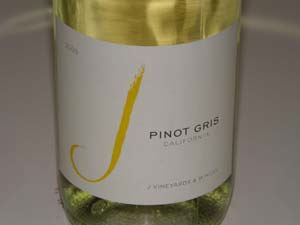 2009 J Vineyards California Pinot Gris 14.3% alc., 20,000 cases, $15, screw cap. Grapes are sourced from Clarksburg (50%), Russian River Valley (43%), and Monterey (7%). Whole cluster gentle pressing, fermented and cooled in stainless steel tanks. No MLF. · Lovely array of tropical fruits with lemon curd in the background. Slightly viscous mouth feel with some persistence on the lengthy finish. A terrific, fruit-forward and crisp food wine that is the best example of this varietal produced in California. Good.
2009 J Vineyards Cooper Vineyard Russian River Valley Pinot Gris 14.3% alc., 500 cases, $20. From clone 152 grown in the J estate vineyard located in front of the winery along Old Redwood Highway. Gently pressing in J’s Coquard press and primary fermentation in stainless steel tanks kept at 55 degrees. · Floral and citrus notes are featured on the nose with a crisp complement of tropical, melon and orange peel flavors. More sophisticated and mineral-imbued than the California bottling. Good.
2008 J Vineyards Russian River Valley Chardonnay 14.3% alc., pH 3.50, 8,000 cases, $28. From J estate vineyards and select vineyard sites in the western Russian River Valley. Whole cluster pressed gently in J’s Coquard press with separate fermentations of free run and press juice. Combination of indigenous and custom Burgundian yeast strains. 100% barrel-fermented slowly in 40% new French oak barrels. Unusual 6-month malolactic fermentation results in a sur lie character. · Straw color in the glass. Heady, vibrant and clean aromas of white peaches, citrus, pineapple, butter and smoky oak. Very tasty offering of lemon curd, fresh brioche, caramel, butterscotch and oak spice highlighted by a smooth and creamy texture. The fruit takes center stage in this wine crafted in an appealing style that most California Chardonnay drinkers will like. Very good.
2008 J Vineyards Russian River Valley Pinot Noir 14.3% alc., pH 3.73, 18,000 cases, $35. From estate vineyards and selected growers. 100% de-stemmed, 3-10 day cold soak, natural fermentation, aged 15 months in 30% new French oak barrels. · Moderate reddish-purple color in the glass. Aromas of dark red berries, red cherry, red plum and rose petals are echoed in the flavors. A charming wine with nuances of earthiness and spice, restrained oak and soft tannins. The most approachable of the 2008 J Pinot Noirs and a reliable table wine. Good.
2008 J Vineyards Barrel 16 Russian River Valley Pinot Noir 14.4% alc., pH 3.64, 300 cases, $50. A special bottling of sixteen barrels chosen by the winemaker to best represent J’s estate vineyards. Aged 12 months in 30% new French oak barrels. Selected barrels were blended and returned to barrel for an additional 3 months. Sold only at the winery and to wine club members. · The least giving and shiest wine tasted on this day, but offering glimpses of a luscious core of black cherry, plum and blackberry fruit, all wrapped in soft, dusty tannins. Full, firm and concentrated, this wine needs another two years in the cellar. Decant if you drink sooner. Very good.
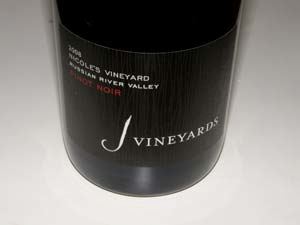 2008 J Vineyards Nicole’s Vineyard Russian River Valley Pinot Noir 14.3% alc., pH 3.79, 720 cases, $50. This vineyard is located off Eastside Road on an eastern bench high above the Russian River and across the River from Rochioli Vineyard. This is one of the warmest sites in J’s vineyard collection. After destemming, the seeds are swept out that fall to the bottom of the tank during fermentation. This helps to eliminate green tannin flavor that immature seeds can often impart. Aged 12 months in 40% new French oak barrels. Selected barrels were blended and returned to barrel for an additional 3 months. · Very shy initially, but comes to life with swirling, offering intense and penetrating scents of ripe plum, black cherry and cassis. Flat-out delicious on the attack with intense and persistent flavors of black cherries and cola. Flavors veer to the ripe, roasted side as would be expected from this warm site in a warm vintage. Very good.
2008 J Vineyards Robert Thomas Vineyard Russian River Valley Pinot Noir 14.3% alc., pH 3.69, 400 cases, $50. Robert Thomas Vineyards is located on Westside Road across from Moshin Vineyards. A cool vineyard amongst redwoods with great soil diversity and a subsurface water table. Because of late harvest, leaves are striped in early October on both the A.M. and P.M. sun side which is unusual for Pinot Noir. A challenging site to farm, but viticultural changes have brought the fruit to ripeness in this vintage. Clones are Rochioli, 2A and Dijon 115. · A husky wine, yet soft in the mouth. Darker cherry and berry fruits with hints of red currant and cola pick up intensity and interest over time in the glass. Noticeable grip of tannin keeps the fruit under wraps now but this youthful wine will be stellar in a year or two. Very good.
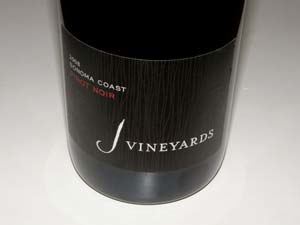 2008 J Vineyards Sonoma Coast Pinot Noir 14.3% alc., pH 3.67, 400 cases, $50. Clones are Pommard and Dijon 115 and 777. Aged 12 months in 30% new French oak barrels. Select barrels were blended and returned to barrel for an additional 3 months. · Moderate reddish-purple color in the glass. Perfume of fresh, exotic wild berries and mushroom with a hint of loamy earth and forest trail. Moderately rich ripe raspberry and plum flavors with a hint of oak spice and citrus. Silky smooth with gossamer tannins, beautiful integration of oak, and an appealing crispness. Very delicate on the palate but packed with flavor. Distinctly different from the Russian River Valley Pinot Noirs from J. Very good.
2002 J Vintage Brut Russian River Valley Sparkling Wine 12.5% alc., pH 3.11, 500 cases, $50. After fermentation in the bottle, the wine was aged for nearly 5 years. In 2006, a dosage of liqueur reserve wine was added to balance the wine and jump start a second fermentation. The wine was aged an additional 6 months on the cork before release. 49% Pinot Noir, 49% Chardonnay, 2% Pinot Meunier. · Aromas of lemon zest, white stone fruits and minerals. Moderately intense lemon and pear flavors follow through to the uplifting finish. Very good.
1999 J Vintage Brut Late Disgorged Russian River Valley Sparkling Wine 12.5% alc., pH 3.11, 550 cases, $65. Sourced from several J estate vineyards including Nicole’s and Nonny’s vineyards. Whole cluster pressed in the Coquard press. Vineyard lots and press fractions were kept separate until blending, after which the wine was cold stabilized and bottled in the spring of 2000. The wine was disgorged after 9 years with a dosage composed of a blend of cask-aged reserve wines and pure cane sugar. After disgorging, the wine aged for another 15 months before release. 51% Chardonnay, 46% Pinot Noir, 3% Pinot Meunier. · Heady aromas of citrus peel, honey, minerals and yeast with delicate flavors of lemon, pear, and spice. Bright and crisp with a fine bubble. Very good.
J Vineyards & Winery has a modern and inviting Visitor Center which is open daily for tasting at 11447 Old Redwood Highway in Healdsburg. The J Visitor Center was the first in the Russian River Valley to offer wine tastings with seasonal food pairings. Visitors can reserve a tasting in the Bubble Room ($60 per person) that offers seating and table service. A seasonal three-course menu created by J Executive Chef Mark E. Caldwell compliments J’s three distinct wine styles: white wines, Pinot Noir, and sparkling wine. Two wines from each category are offered plus a taste of J’s Ratafia dessert wine at the conclusion of the tasting menu. I have brought a number of people to the Bubble Room tasting and my guests have always been extremely impressed by the wines, the food and the ambiance. J’s white wines, Cuvée 20 Brut NV and Brut Rosé, and the Russian River Valley appellation blend Pinot Noir are in widespread retail distribution. The limited production Pinot Noir bottlings and Late Disgorged sparkling wine are primarily winery-only offerings.
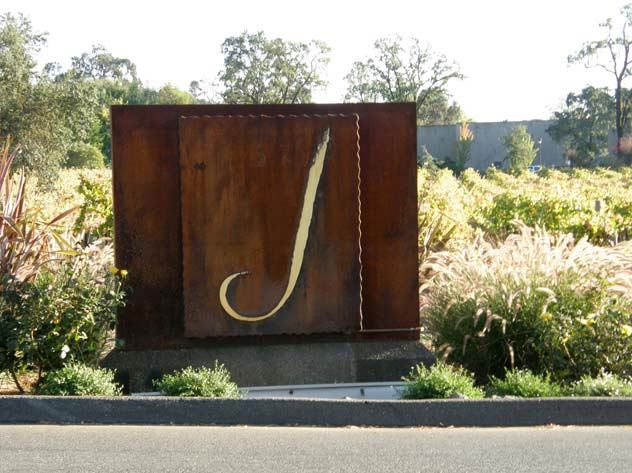
Talisman Continues to ExcelLast year I wrote a feature on Scott and Marta Rich and the outstanding age worthy Pinot Noirs they have been producing since 1993. I have tasted Scott’s wines dating back to the 1997 vintage and have had nothing but high praise for every release I have sampled. The three 2007 wines reviewed below are no exception. Scott is a lover of unique Pinot Noir terroirs and searches for sites that are challenging but expressive. He says, “I like to express terroir - that is the beauty of Pinot Noir - and that comes through in the more extreme vineyard sites.” Scott believes his wines best express their terroir after some aging so he directs his winemaking toward producing wines with potential for longevity. He notes, “I make my wines to age, even if on one gives them a chance.” Because of his insistence on age ability, his wines are not flashy when young. Aware of this, he carefully barrel and bottle ages his wines before offering them so they are approachable upon release. His current releases reviewed below are from the 2007 vintage and have been released at a time when some producers are already releasing their 2009 vintage wines.
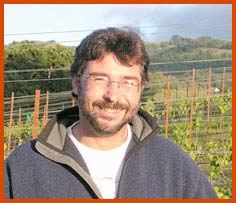 Scott’s refined winemaking style leads to consistently classic Pinot Noir that is pure, nuanced and balanced. You won’t find any jelly jar blockbusters, but the wines are not wimpy by any means. As you read through the reviews below, you will find a consistency of quality combined with a distinctiveness that reflects each wine’s unique site of origin. The 2007 Pinot Noirs show a more gentle touch and are more approachable than usual. That said, all the wines will age very well. I suggest buying several bottles of your favorites, lay them down in your cellar, and follow their progress over the next 10 to 15 years. It could be a revelation. Talisman small production Pinot Noirs are sold online at www.talismanwine.com and through a mailing list. The wines are reasonably priced considering the high quality. The small winery is in the town of Sonoma in a somewhat hidden enclave of artisan wineries (Eighth Street Wineries - www.eighthstreetwineries.com). Tasting is by appointment (707-258-5722). Scott and Marta are very gracious and you will thoroughly enjoy a visit to their humble winery.
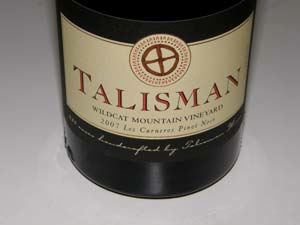 2007 Talisman Gunsalus Vineyard Russian River Valley Pinot Noir 14.5% alc., pH 3.71, 296 cases, $36. Pamela and Glen Gunsalus farm this vineyard located in Green Valley. Dijon clones 114, 115, 667 and 777 are planted in Sebastopol loam and Goldridge sand loam soils. All clones co-fermented with 25% whole cluster inclusion and indigenous yeasts. Aged 20 months in 71% new French oak barrels. · Impressive fruit expression on the nose and in the mouth with a seamless texture. Spiced Bing cherries, cherry cola and nutmeg fill out the aromatic and flavor profile. The oak is perfectly integrated, the tannins are ripe and silky, and the finish is long and memorable. I could drink this all night long. Still great the next day from a previously opened and re-corked bottle. An engaging, age worthy Pinot Noir that has all the right stuff.
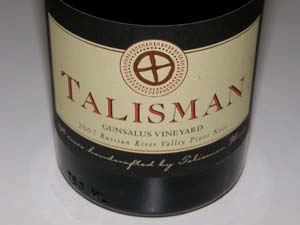 2007 Talisman Wildcat Mountain Vineyard Los Carneros Pinot Noir 14.5% alc., pH 3.78, 230 cases, $45. This vineyard is located on the southern flank of the mountain range defining the western edge of Sonoma Valley. It is the highest vineyard in the Los Carneros appellation, sitting on well drained soils of volcanic origin and exposed to the full brunt of fog and cold winds that streams off San Pablo Bay. The vineyard was established in 1998 by Nancy and Tony Lilly with their partner Steve MacRostie. Clones are Swan, Pommard, Dijon 115 and 777. 25% whole cluster. Indigenous yeast fermentation with an extended maceration after fermentation was complete. · A very unique wine that I find challenging to describe. The nose offers appealing aromas of wild dark berries, underbrush, pine and oak, with the fruit coming to the forefront over time in the glass. More savory than fruity on the palate with substantial tannins and a hint of grapefruit on the smooth finish. The combination of clones and distinctive terroir create a wine that stands apart. Very good.
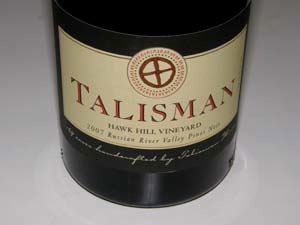 2007 Talisman Hawk Hill Vineyard Russian River Valley Pinot Noir 14.5% alc., pH 3.65, 169 cases, $46. This vineyard sits in a foggy slot in far west Sonoma County near Freestone. The soils are classic Goldridge series. Clones are Pommard and Dijon 115. 25% whole cluster. Indigenous yeast fermentation. Aged 20 months in 70% new French oak barrels and received an additional year of bottle age before release. · Flashy aroma of ripe black cherries with a kiss of oak. Delicious array of dark red and black cherry and berry flavors with a perfect compliment of oak spice. The generous finish wows you. Lip-smacking good. Still fine the next two days from a previously opened and re-corked bottle.
Iconic Calera Wine Company: 32 Vintages of Estate Pinot Noir
the New World but of Planet Earth. Credit must be extended to its visionary founder, proprietor Josh Jensen. Ironically, today Jensen rarely gets the acclaim that these wines merit.” Marq De Villiers, The Heartbreak Grape
In 1975, when Josh Jensen first planted his vines on a remote property in the Gavilan Mountains, he was among a few pioneers at the time who were attempting to farm and produce Pinot Noir in California. Dick Graff had preceded Jensen by ten years at Chalone, located just north of Calera in the same Gavilan Mountain Range in California’s San Benito County. Others included Richard Sanford in Santa Barabara County, David Bruce and Merry Edwards in the Santa Cruz Mountains, Joseph Swan, Bob Pellegrini and Joe Rochioli in the Russian River Valley, Tony Husch in the Anderson Valley, and Francis Mahoney in Carneros. As it would turn out, despite the diversity of microclimates each grower settled on, all of them proved very successful. There was only one innovator other than Graff who based his whole success on limestone. A student and fervent lover of the wines of Burgundy, Jensen was convinced that it was the limestone in the soil of Burgundy that made the wines so special. Jensen has said, “Here in this country, the establishment doesn’t think limestone is important. I didn’t waste my time debating it. I just saw where the great Burgundies grow and decided to let my wines do the talking.” Jensen’s remarkable story was first told in detail in 1993 in the first edition of the book, The Heartbreak Grape: A Journey in Search of the Perfect Pinot Noir, written by Marq de Villiers. A revised and updated version was published in 2006. Jensen’s saga is an inspiration for anyone hoping to follow a passion for Pinot Noir. After thirty-two vintages of Calera Estate Pinot Noir, his initial heartbreaking efforts have found vindication, and Pinot Noir from California, and in particular those from Calera, can hold their own to the best from Burgundy. Read my extensive coverage of the history of Calera and my review of the 2005 Calera wines in a previous issue of the PinotFile (www.princeofpinot.com/article/129/).
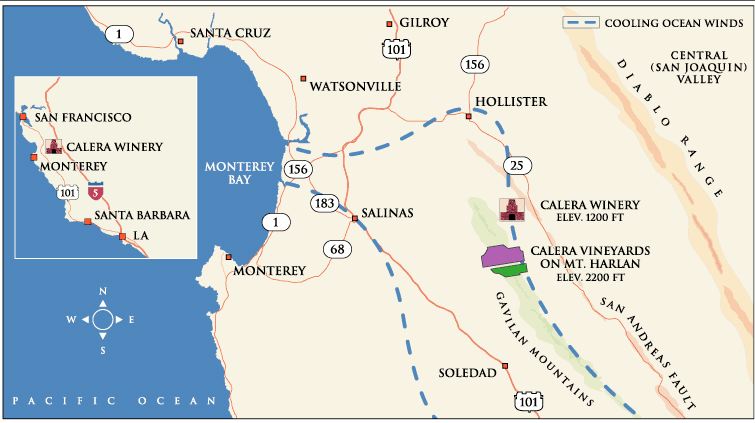 Calera wines are vinified in a 7-tier gravity flow winery built into the side of a mountain. Non interventionist techniques are employed including native yeast and whole cluster fermentations, and minimal racking. Pinot Noir grapes are fermented warm in open-top fermenters. The lots are pressed after a minimum of 14 days in the fermenter. Aging is in 60 gallon French oak barrels from Francois Freres in Calera’s two barrel cellars. The single vineyard Pinot Noirs receive 16 months of aging in barrels, 30% of which are new each vintage. The Central Coast wines are aged in 12-15% new barrels for 10 to 11 months. The wines are fined with egg whites to ensure clarity and are bottled after settling unfiltered.
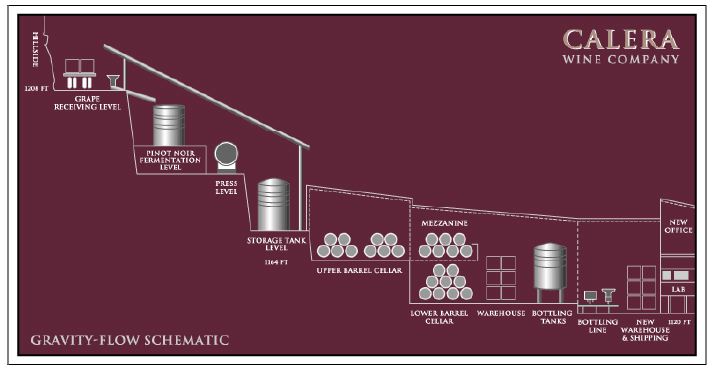 The Calera property consists of 648 acres and 440 adjacent acres with 84 acres planted by 2006. The first vintage of estate Pinot Noir was 1978, all of 700 cases in half-bottles, and was the initial Calera wine made at the winery. Calera is the only winery in the Mt. Harlan AVA. The vineyards are in the Mt. Harlan AVA, but the winery is technically not, so Jensen cannot use “estate bottled” on the label.
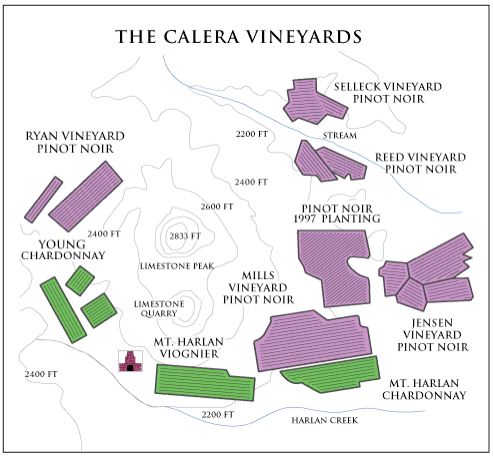 According to John Haeger, writing in Pacific Pinot Noir, Jensen was an admirer of Dick Graff’s Chalone Vineyard Pinot Noirs and used Chalone budwood for the original 1975 plantings of Selleck, Reed and one-third of Jensen. Two-thirds of Jensen was planted from nursery bench grafts originating in California. Rumors persist that suitcase clones may have been brought in from Burgundy by Jensen, planted at Chalone, and the Calera plantings actually represent second generation budwood that originated in Burgundy (? Domaine de la Romanée-Conti). The Mills Vineyard, Chardonnay and second planting of Viognier are own rooted, the rest of the plantings are grafted onto nursery rootstock. Mills was planted with budwood from Selleck in 1984. The de Villiers Vineyard (not named on the map above) is a new 15.6-acre planting established in 1997. The Calera Pinot Noirs are one of the closest to the Burgundian idiom in California. The wines are reticent upon release, with the best drinking window between 5 and 20 years after the vintage. Josh Jensen describes the Pinot Noirs from his four separate vineyards as follows. “Jensen is a complex wine and for me consistency of complexity is really the ultimate compliment to a Pinot Noir. Jensen is usually the most tannic and the leanest and least rounded. It has some type of olive character, a spiciness. The Reed in most years has a sort of chocolaty, raisiny character. In personality it has acquired a softness and precociousness. The Selleck is my personal favorite almost every vintage. It is also the fastest to evolve. It seems to have one more layer, one more bit of depth and complexity than the others, and since that’s what I appreciate the most, it appeals to me the most. The Selleck is the most feminine of our wines and the most subtle. It seems to taste of spice, nutmeg, truffles and earth together, and floral, so it is complete and complex. The Mills has terrific structure but it often seems leaner than the other three. Compared to any other Pinot Noir from any other producer it is rich, full flavored, dark and complex. Compared to our own vineyards, it seems less rounded and supple and fat by comparison.”
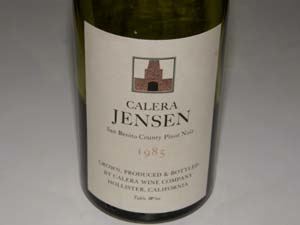 I recently tasted through several newly released 2007 Calera wines. I spend considerable time looking at many of the newer producers of Pinot Noir, but always follow an early inspiration I had. The first case of Pinot Noir I ever bought was the 1985 Calera Jensen Pinot Noir which was one of my early Pinot Noir epiphanies. Recently, one of my readers, aware of my fascination with this wine, sent me a few half bottles of the 1985 Calera Jensen Pinot Noir he had found in the back of his cellar. I opened two bottles, expecting some bottle variation which I found. Both bottles had soft, crumbly corks. The first bottle had a marked brownish caste but deep color. Aromas of shoe leather, mushrooms and raisin. The fruit had faded and the dry dusty tannins and acidity had come to the forefront. The flavor profile featured black cherry, sassafras, raisin, cola and black tea. The wine was very tart and seemed slightly oxidized. A second bottle was better with less brown discoloration. The nose offered aromas of smoke, roasted nuts and old wood with shy fruit. There was more flavor intensity and charm with tastes of tart black cherry and cola, but the dry plentiful tannins and acidity still won out over the faded fruit. Half-bottles are never a good choice for aging wine and this was confirmed. That said, it is still a wonderful experience to open old wines and challenge the senses. Although my reviews of the 2007 Calera wines were not as effusive as Robert Parker’s (he gave the 2007 Calera Chardonnay Mt. Harlan a score of 96, the 2007 Calera Jensen Vineyard Pinot Noir a score of 97 and the 2007 Calera Selleck Vineyard a score of 98), I found these wines are definitely worth acquiring and cellaring. Parker said, “This may be the strongest group of wines Calera has produced in many years.” It is of great interest that Parker loves Calera Pinot Noirs, although they are definitely not the big-boned, highly extracted style that Parker seems to prefer from other producers in California. All the Pinot Noirs are moderately light in color intensity. The wines need time to integrate the flamboyant fruit tannins. My biggest nit about some of these wines is the high alcohol which shows up on the finish. Except for the Reed Vineyard bottling, don’t even think about popping the corks on these wines for 3 to 4 years. The aromas are more showy than the flavors at this stage. Since I rate wines more on their current drinking charm rather than predicting the future, the obvious potential of these extraordinary wines will undoubtedly lead to more glorious reviews in the years to follow. Some of these wines will easily go 15 to 20 years. Don’t ignore the white wines for they are among the finest made in California today. The back labels of Calera wines give you the kind of useful and detailed information you desire about the wine. Jensen avoids the often displayed superlatives, the flowery, hollow talk like “made in the best winemaking tradition,” or “sourced from the finest vineyards.”
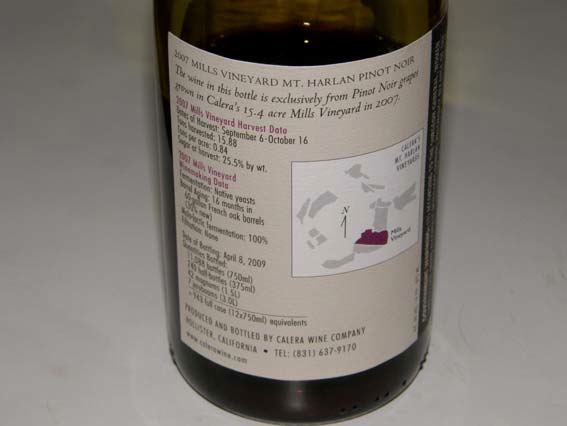
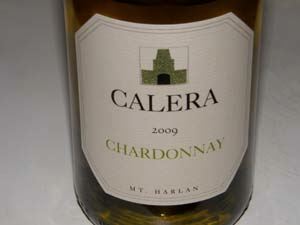 2009 Calera Mt. Harlan Chardonnay 13.9% alc., 1,035 cases, $28. From organically grown grapes. Yields were 1.65 tons per acre. Aged 10 months in 30% new French oak barrels. 100% MLF. · Light straw in color. Aromas of citrus fruits, apple and peach. Very tasty and complex flavors of spiced pears, limes, lemons, brioche and oak. The toasty oak in the background adds rather than detracts. Very clean, crisp and understated with a slightly creamy texture. Beautifully balanced for longevity. Incredible value. Very good.
2009 Calera Mt. Harlan Viognier 13.9% alc., 468 cases, $30. From a 6.1-acre vineyard that is organically farmed. Yields of 1.25 tons per acre. Aged 10 months in French oak barrels. 100% MLF. · Light straw color in the glass. Lovely perfume of tropical fruits including papaya with notes of lemon curd and honeysuckle. Moderately rich with plenty of glycerin intensity and minerality. Tasty composite of pineapple, roasted apple, poppyseed and white peach leading to a clean, richly fruited finish. Very impressive and the best example of this varietal currently being produced in California. Very good.
2007 Calera de Villiers Vineyard Mt. Harlan Pinot Noir 14.9% alc., 631 cases, $35. 30% of the fruit from this relatively young (for Calera) vineyard was de-classified. Yields were a ridiculous .78 tons per acre. Aged 16 months in 20% new French oak barrels. · The pleasing aromas trump the flavors. Welcoming scents of plums, berries, brioche and cut flowers. Tart cherry and berry flavors with a short, hot finish. The flamboyant tannins and lively acidity obscure the substantial fruit at this point. Cellar this one for sure. Decent.
2007 Calera Ryan Vineyard Mt. Harlan Pinot Noir 14.8% alc., 1,847 cases, $40. Yields were 2.45 tons per acre. Aged 17 months in 30% new French oak barrels. · Attractive perfume of red plums, berries, cedar and Herbs de Provence. Moderately light in style featuring redder fruits, earth, meat and stem accents, smoothly textured, with plenty of tannin on the hot finish. Decent.
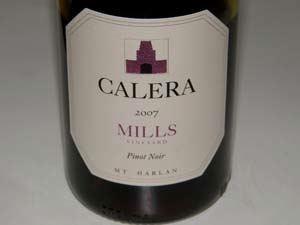 2007 Calera Mills Vineyard Mt. Harlan Pinot Noir 14.9% alc., 943 cases, $45. Yields .84 tons per acre. · The nose is complex and alluring, offering scents of black cherries, caramel, oak vanillin and cut flowers. Restrained and demure dark red fruits have a hint of stem and mushroom, with admirable persistence on the finish. The texture is striking for its sexy silkiness. A little heat lingers in the after taste. Very good.
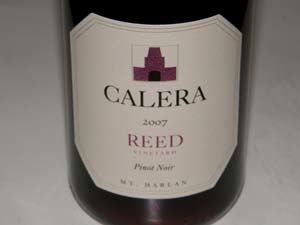 2007 Calera Reed Vineyard Mt. Harlan Pinot Noir 14.2% alc., 190 cases, $50. Very low yields of 0.9 tons per acre. Aged 16 months in 30% new French oak barrels. · Lightest in color of the Calera Pinot Noirs in 2007. Terrific nose that really draws you to the wine featuring aromas of red raspberries, strawberries, cranberries, rose hips, tea and balsam. The most delicate and feminine, least tannic, and most approachable Pinot Noir in the lineup offering discreetly concentrated red berry fruit, sandalwood, baking spice and herbal flavors. Very good.
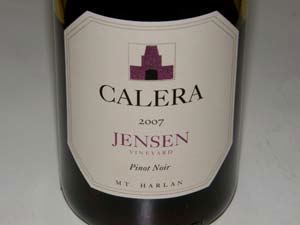 2007 Calera Jensen Vineyard Mt. Harlan Pinot Noir 14.9% alc., 1,113 cases, $70. 13.5% of the crop was declassified. Yields of 1.46 tons per acre. Aged 16 months in 30% new French oak barrels. · The most vibrant and captivating nose in the lineup revealing an array of high-pitched wild berries, ripe strawberries, and black cherries with a subtle conifer and stem note. Luscious core of fruit echoing the aromas with impeccable balance and a smooth, silky texture. Impressive persistence of fruit flavors on the high-tone finish. A legend in the making.
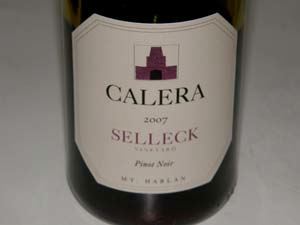 2007 Calera Selleck Vineyard Mt. Harlan Pinot Noir 14.8% alc., 411 cases, $75. Yields were 1.36 tons per acre. Aged 16 months in 30% new French oak barrels. · Lovely full-on perfume of black cherries, red plums, spice box and roses. Juicy and succulent berry fruit flavors nicely spiced and framed with well-honed tannins and bright acidity. Tastes like the best berry compote you have ever had. A little heat peaks out on the finish, but this is otherwise a very charming wine that is hard to say no to.
Other current Calera offerings include: 2009 Central Coast Chardonnay ($16), 2009 Central Coast Vin Gris of Pinot Noir ($16), 2009 Central Coast Viognier ($16), 2009 Mt. Harlan Aligote ($20), 2008 Central Coast Pinot Noir ($24), and 2007 Mt. Harlan Cuvée Pinot Noir ($30). The Mt. Harlan Cuvée is a barrel selection from the various single-vineyard Pinot Noirs. I did not taste this wine but I blended equal amounts of the single vineyard wines reviewed above for the heck of it. The resulting wine was brooding and linear without nuance but it was pretty tasty. The Central Coast vineyard sources are multiple and are listed on the website. Calera wines are sold through the winery’s online store at www.shop.calerawine.com. The de Villiers and Reed bottlings are sold out. The 2006 Reed is being offered in its place. Look for older vintages offered by Calera of vineyard-designated Pinot Noir that have been cellared perfectly at the winery. Jensen's newsletters are a treasure but he unfortunately publishes them very sporadically.
St. Innocent WinerySt. Innocent Winery is a well-established and prestigious maker of Pinot Noir and cool climate white wines based in Salem, Oregon. Established in 1988, winemaker Mark Vlossek produces age worthy Pinot Noirs from estate (80 acres owned) and leased (40 acres) vineyards. The winery’s reputation has been built on vineyard designated Pinot Noir from purchased grapes. Yearly wine production is just under 10,000 cases. The name, St. Innocent, is in honor of Mark’s father, John Innocent Vlossak, who was a wine importer and introduced his son to the pleasures of fine wine at a young age. John was born on All Innocents Day. Early on, Mark Vlossek was also the winemaker for Panther Creek Winery, where he acquired his Pinot Noir winemaking expertise. The first St. Innocent Pinot Noir was from the 1998 vintage which was a blend from several Willamette Valley vineyards. This wine was to later be replaced by the Villages Cuvée which debuted in 2002. In 2006, St. Innocent Winery joined with Tim and Kari Ramey as partners in Zenith Vineyard (formerly O’Connor Vineyard from which Vlossak had sourced fruit) in the Eola Hills. Zenith Vineyard has a total of 13.5 acres of Pinot Noir exclusively for St. Innocent’s use with some additional fruit sold to wineries in Oregon and California. St. Innocent’s new winery and Zenith’s wedding and event facility located adjacent Zenith Vineyard compliment each other. Currently, the lineup of single vineyard Pinot Noir includes wines from Freedom Hill Vineyard, Justice Vineyard, Momtazi Vineyard, Shea Vineyard, Temperance Hill Vineyard, White Rose Vineyard and Zenith Vineyard. St. Innocent was a long time purchaser of fruit from Seven Springs Vineyard but due to its sale, no longer has access to the fruit (the 2006 St. Innocent Seven Springs Vineyard Pinot Noir, the last produced, is available on the winery website for $100 a bottle). The St. Innocent Pinot Noirs are classic expressions of Pinot Noir with exquisite balance and generous acidity. They are terroir-driven wines that show both the character of the site and the vintage. Vlossak’s goal is to create wines to “compliment and extend the pleasure of a meal.” The fruit is de-stemmed, crushed with 30%-40% whole berries, and fermented in 3 to 8-ton fermenters with no sulfur dioxide after a short cold soak. Aging is carried out for 15-17 months in French oak barrels with the amount of new wood matched to individual vineyards. The wines are rarely fined, racked or filtered. Visit the informative website at www.stinnocentwine.com for more detailed description of the vineyard sources and to buy the current 2008 vintage wines. Unfortunately, the Shea, Justice and Zenith Pinot Noirs for 2008 are sold out, but are available on the secondary market. The Shea and Freedom Hill Pinot Noirs are sold as futures each year, and the 2009 vintage for these wines is now offered. The beautiful tasting room is open Tuesday-Sunday from May 1 to October 31 and weekends 11:00 to 4:00 year round. Open Houses are over Memorial Day and Thanksgiving Day weekends. Private tours and tastings are available by appointment. I recently sampled several of the 2008 St. Innocent offerings. This vintage was the second one in the new winery facility and harvest was blessed with good weather. Yields were reduced from most sites, but the weather remained dry until Halloween, allowing leisurely picking at each vineyard site. The single vineyard wines need time to develop.
2008 St. Innocent Freedom Hill Vineyard Willamette Valley Pinot Blanc 13.5% alc., 605 cases, $20. Planted in 1993. Fermented 31% in barrel and 69% in tank. Aged 8 months sur lies. · Light straw color in the glass. Delicate aromas of lemon curd and pastry cream. Demure flavors of citrus, peach, green apple and a hint of oak. Oregon does well with this grape and this is a fine example. Good.
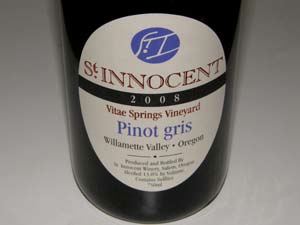 2008 St. Innocent Vitae Springs Vineyard Willamette Valley Pinot Gris 13.0% alc., 752 cases, $20. Vitae Springs was established in 1986 and is located 5 miles south of Salem. Tank fermented, aged 8 months sur lie, and lightly filtered. No oak. · Light straw color. Aromas of white orchard fruits and a hint of pineapple. The flavors echo the aromas with added notes of spice and lychee. Welcoming richness and persistence. One of Oregon’s best examples of this variety. Very good.
2008 St. Innocent Villages Cuvée Willamette Valley Pinot Noir 13.5% alc., $27. · Moderate reddish-purple hue in the glass. Develops slowly in the glass revealing charming aromas of raspberries and cherries with hints of smoky oak and spice. Vivid cranberry and cherry fruit flavors that are a bit tart due to hi-tone acidity. On the delicate side, with supple tannins, making it easy to drink. Good.
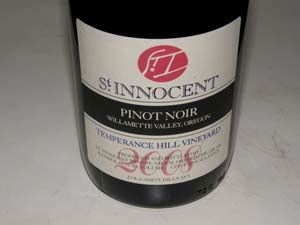 2008 St. Innocent Temperance Hill Eola-Amity Hills Willamette Valley Pinot Noir 13.5% alc., 656 cases, $32. The vineyard is 10 miles northwest of Salem. Sourced from blocks planted in 1984 and 1995. Yields 1.6 tons per acre. · The nose draws you in with a perfume of dark berry fruits, rose petals and oak char. Soft and sensual in the mouth with layers of flavor including tastes of dark berries, black cherries, plum, cola, tar, brown spice, root beer and herbs. A thread of oak runs through which needs time to integrate. Underlain with bright acidity. Elegantly styled and alluring, but needs time to open in the glass. The label advises decanting now and I agree completely. An excellent cellar candidate that will reward patience. Very good.
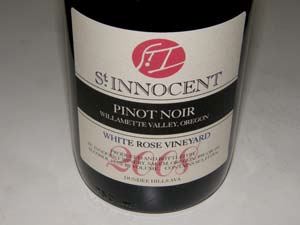 2008 St. Innocent Shea Vineyard Yamhill-Carlton District Willamette Valley Pinot Noir 14.2% alc., $42. From Block 6 planted in 1998 and 2000 on shallow Willakenzie soil. Yields were 2.0 tons per acre. 100% de-stemmed. Aged 16 months in 39% new French oak barrels. · Deep, dark reddish-purple color in the glass. The nose is reluctant and has not come together but offers some charms of black fruits, oak, loam and red rose petals. Dense flavors of black currents, blackberries, black cherries and edible flowers with flamboyant ripe tannins. Not giving now but has a big heart and a welcoming silky smooth mouth feel. Give this one at least 4 to 5 years in the cellar to integrate the tannins and show off the nuances of this vineyard. Very good.
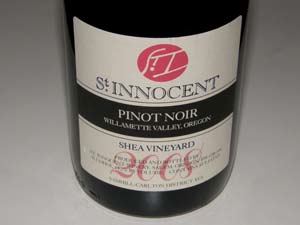 2008 St. Innocent White Rose Vineyard Dundee Hills Willamette Valley Pinot Noir 13.5% alc., $60. · Moderate reddish-purple color. Shy but lovely perfume of fresh pie cherries with a sniff of smoky oak. An immensely satisfying wine offering delicious black cherry and berry flavors with a hint of citrus peel in the background. Amazing persistence of cherry essence on the finish. Silky in the mouth with balanced supple tannins. This wine really grabs your attention. You can drink it now but it will get even better over time.
Chasseur West County WinesWinemaker Bill Hunter is one of a band of vintners focused on the Pinot Noir grown in “West County,” the far western Russian River Valley and true Sonoma Coast region encompassing western Sebastopol, Freestone, and the town of Occidental. Hunter is a graduate of University of California at Davis and gained his early winemaking experience at Rombauer, Bonny Doon and Chauffe-Eau Cellars. In 1994, he began making some of his own wine on the side, starting with two barrels of Dutton Chardonnay and one barrel of Carneros Pinot Noir. This led to the founding of his own label, Chasseur, the French word for hunter. In 2002, Hunter brought on Alex P. Bartholomaus, Managing Director of Billington Imports as an investment partner, allowing Hunter to devote himself full time to making wine at Chasseur. Hunter now quietly produces 2,700 cases annually of Pinot Noir and Chardonnay at his winery in Sebastopol, located inside the Vacu-Dry apple processing plant on Gravenstein Highway. There are six vineyard-designated Pinot Noirs for the 2008 vintage: Blank, Sexton, Holder, Umino, Rayhill and Joyce. Another usual source, Freestone Station Vineyard, was lost to spring frost and Sylvia’s was declassified. There was no smoke damage in the central West County vineyards used by Chasseur in 2008. Hunter notes that the 2008 wines are similar in quality to the elegant 2007s, but are bigger and fuller. I preferred the 2007 lineup of Chasseur Pinot Noirs (see www.princeofpinot.com/article/816/) over the 2008 wines reviewed below. Still, the 2008 wines are well-crafted, showing bright fruit flavors, firm but restrained tannins, bright acidity and a consistency of quality. At this stage, the wines lack aromatic and textural interest, want for intrigue and nuance, and all taste very similar. I am sure that Hunter, who tastes the wines frequently, can make distinctions among the separate bottlings, but with a one-time taste through for me, it was difficult to arrive at significant differences. This may be partly attributable to the fact that all the vineyard sources are made up of very similar Dijon clone components. Chasseur Pinot Noirs are aged 14 months in French oak barrels and bottled unfined and unfiltered. Chasseur’s two appellations Pinot Noirs (Sonoma Coast and Russian River Valley) are available in some retail markets, but the single-vineyard Pinot Noirs are allocated and sold primarily through a mailing list. Declassified juice goes into a second label, Cazar. I had Chasseur Chardonnay on two occasions in the past, and found the wines exemplary. A Vin Gris of Pinot Noir is also available. Consult the website (www.chasseurwines.com) to join the mailing list or to buy wines. Tasting is available by appointment on Fridays. Hunter is a bit of an outlier in that he does not submit his wines for review to critics. I bought these wines to sample them. I admire him for not promoting the scoring of wine.
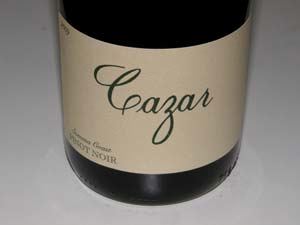 2009 Cazar Sonoma Coast Pinot Noir 14.5% alc., $19. From several Sonoma Coast vineyards. · Moderately deep reddish-purple color in the glass. Overriding the appealing aromas of dark berry jam and black grapes are notes of tobacco, hay and grass (the kind you smoke). This carries over on the palate with blackberry and plum flavors accented by notes of grass, herbs and stem. Moderately dense fruit, silky smooth, and nicely balanced with some hi-tone fruit on the lingering finish. Decent.
2008 Chasseur Holder Russian River Valley Pinot Noir 14.7% alc., 75 cases, $50. Dijon clones 115 and 667. · This wine offers the most charming aromatics in the lineup with aromas of black cherry tart, spice and oak bark. Intense and dense charge of black cherry and plum fruit with complimentary spice and cola accents. Almost black cherry liquor in intensity but not syrupy. This one is all about amazing fruit that persists on the finish for at least a minute. The tannins are supple and proportioned well to the generous fruit, while the acidity seems slightly overwhelmed, failing to bring the fruit to a high pitch. This one will have fans among Caliesque fruit hedonists. Very good.
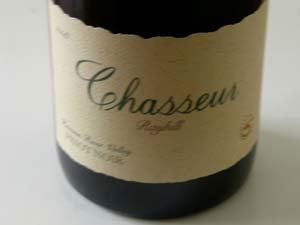 2008 Chasseur Rayhill Russian River Valley Pinot Noir 14.0% alc., 125 cases, $55. Dijon clones 115, 667and 777. · The nose is not forthcoming offering only subtle whiffs of fruit, oak and redwood. Moderately intense and tasty essence of dark red cherries and berries with some persistence on the finish. Nicely balanced t n’a. A fruit driven wine that is well-rounded and picks up interest over time in the glass. Definitely cellar this one. Very Good.
2008 Chasseur Sexton Russian River Valley Pinot Noir 15.0% alc., 150 cases, $55. Dijon clones 113, 114 and 115. · Aromas of spice box, leaf and tar with very shy fruit. Tasty dark cherry and berry core with an alluring spice component. Soft tannins and bright acidity. Despite the high alcohol, not excessively sweet or cloying. Hard to ignore the luscious fruit. Good.
2008 Chasseur Blank Russian River Valley Pinot Noir 14.3% alc., 250 cases, $60. Dijon clones 115 and 777 cropped at 2.2 tons per acre at Blank Road Vineyard. · On the nose there are shy dark red raspberries and strawberries with whiffs of anise, oak and campfire. Tangy array of raspberry and pomegranate flavors with a green note in the background and a mineral streak. Harmonious tannins and zippy acidity. Decent.
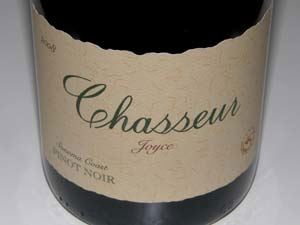 2008 Chasseur Joyce Sonoma Coast Pinot Noir 14.0% alc., 225 cases, $60. Dijon clones 115 and 777. · Appealing scent of pie cherries, berry jam and a hint of allspice. Nice array of cherry and berry fruits that really grab hold, wrapped in firm, mouth-coating tannins and persisting on the finish that has a bit of a sauvage character. Impressive expression of layered fruit here. Very good.
2008 Chasseur Umino Russian River Valley Pinot Noir 14.4% alc., 150 cases, $60. Dijon clones 115, 777, 667 and 459. · The nose is closed for business but with extensive swirling reveals scents of dark berry jam, oak and pine needle. Linear essence of dark raspberries, strawberries and cherries with generous oak. Pretty ordinary. May develop more interest with cellaring. Decent.
Sips of Pinot2008 Alysian Cresta Ridge Vineyard Taurin Block Russian River Valley Chardonnay 14.1% alc., pH 3.47, 378 cases, $38. Gary Farrell’s 2008 lineup of wines are very impressive. Sourced from a Green Valley vineyard. 100% barrel fermented, 50% MLF in barrel. Aged 10 months in 40% new and 60% one and two-year-old French oak barrels. Sold only through a mailing list. · Light straw color in the glass. Fresh aromas of white stone fruits, butterscotch and buttered toast. Delicious and persistent moderately rich mix of flavors including pears, white peach, green apple, biscuit and maple syrup framed by lively acidity with a subtle note of oak in the background. Uncommon tenacity of flavor for a Chardonnay. Everything is singing in harmony and this wine is just my style.
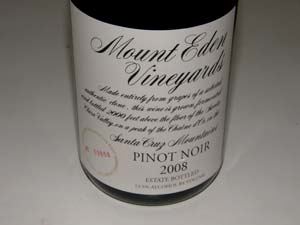 2008 Mount Eden Vineyards Estate Santa Cruz Mountains Pinot Noir 13.5% alc., 985 cases, $46. Estate grown and bottled. · Moderately light reddish-purple color in the glass. Nicely composed aromatic profile of cherries, strawberries, savory herbs, and oak blossoming in the glass over time. A magnificent Burgundian styled wine with vivid, high-pitched red cherry, raspberry and cranberry flavors framed by lively acidity and fine grain tannins, and beautifully underlain with minerality. Has the balance to age for 20 years. After so many years at the helm, winemaker Jeffrey Patterson knows his vineyard and consistently offers Pinot Noirs styled with the type of charm and restraint that is often lacking in so many fruit driven California Pinot Noirs. A great food wine that should be cause for celebration. (See Bucket List at end of this issue).
2008 Talley Vineyards Rincon Vineyard Arroyo Grande Valley Pinot Noir 14.5% alc., 375 cases, $50. · Deep reddish-purple color in the glass. The nose is clamped down and it is difficult to coax out any fruit. Oak vanillin aroma is about all you get. Dense and tasty essence of purple fruits with firm tannins. An impressive mouthful of fruit but needs cellaring to integrate the tannins and oak and come out of its shell. Find a good steak or short ribs to accompany this wine if you open it now. Good.
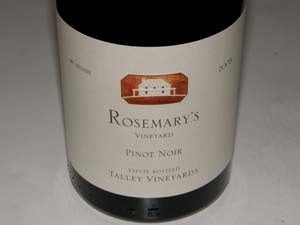 2008 Talley Vineyards Rosemary’s Vineyard Arroyo Grande Valley Pinot Noir 13.9% alc., 400 cases, $60. · Deep dark reddish-purple color in the glass. More giving than the Rincon bottling offering pleasing aromas and flavors of red and black fruits especially black cherries and strawberries, all nicely spiced. Big-boned and fruit driven with healthy tannins. Needs a few years in the cellar for optimum enjoyment. Very good.
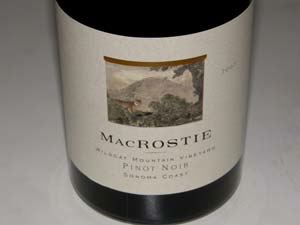 2007 MacRostie Wildcat Mountain Vineyard Sonoma Coast Pinot Noir 14.2% alc., 1,000 cases, $30. Steve MacRostie owner, Kevin W. Holt winemaker. · Blackberry and plum aromas arrive over time in the glass with interesting nuances of underbrush, oak and Asian 5-spice. A husky, rugged wine featuring black raspberry and blackberry flavors backed by a good grip of citric acidity and complimented by an earthy, stem accent. The silky texture adds to the appeal. Very good.
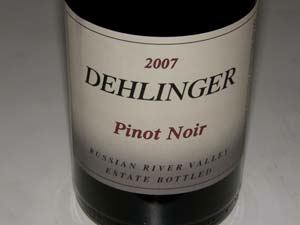 2007 Dehlinger Estate Bottled Russian River Valley Pinot Noir 14.9% alc., $48. · Moderate reddishpurple hue in the glass. Lovely perfume of black cherries, black raspberries, and seasonal fall spices. Mouth coating fruit core that grabs hold and made even more charming by gossamer tannins and a slippery, refined mouth feel. Nice accents of cola and spice. This wine has plenty of fruit charisma and will find many fans. An iconic winery that keeps doing its thing very well.
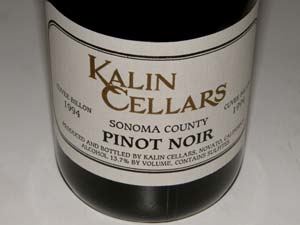 1994 Kalin Cellars Cuvée Billon Sonoma County Pinot Noir 13.7% alc., $58. · Moderate color with a slight yellowing of the edge in the glass. Very interesting bouquet of raspberries, mushrooms, black cherries, bay leaf and Herbs de Provence. Slightly tart and rustic but pleasing flavors of cherries and berries accented with savory (unami) notes and leading to a bright finish with a grip of citric tang. Some dusty tannins persist to round out the wine. Lovers of older California Pinot Noir will really enjoy this wine. Very good.
Pinot BriefsHong Kong Falling in Love with Burgundy As reported in www.wines-info.com, there is increasing demand for fine Burgundy in the Hong Kong marketplace, spelling doom for finding good value in wines from this region after the 2009 vintage. Burgundy’s appeal is its attractiveness when younger compared to Bordeaux. Most interest is centered on Domaine de la Romanée-Conti and Domaine Leroy at present, but the demand for Burgundy should become more broad-based in time. Rhone and Italian wines may become increasingly favored in the Far East as well. “Flights and Bites” Wine Weekend in Santa Maria Valley On December 4 and 5, Santa Maria Valley wine country will have a food and wine pairing passport weekend. On Saturday, December 4, participants travel to four wineries (Costa de Oro, Kenneth Volk Vineyards, Riverbench Winery and Core Wines) to sample wines paired with food. On Sunday, December 5, other Santa Maria Valley wineries will have special Open Houses. Special lodging rates are available at the historic Santa Maria Inn, Rodeway Inn and Radisson Hotel. Tickets ($25) are available at www.shop.smvwines.com.
 VineStories.com After living and working in Los Angeles for 20 years, Bob Wittenberg and Jacqueline DiBernardo have moved to Portland, Oregon and started a small video production company that merges their interest in small production wineries (particularly Pinot Noir producers) with their background in writing and directing. The videos are mini-documentary conversations with winemakers, intended to be both educational and entertaining. Wineries featured so far in Oregon include Amalie Robert Estate, Cameron Winery, Coelho Winery, Daedalus Cellars, Sineann and Wy’East Vineyards. California and Washington wineries are also featured. Visit www.vinestories.com. Robert Parker Still Shut Out of Vintners Hall of Fame The excellent wine blog, “The Wine Curmudgeon,” reports that Robert Parker has been nominated for inclusion in the Vintners Hall of Fame the past two years, but has not received enough affirmative votes. Joel Peterson of Ravenswood, Vernon Singleton of the University of California at Davis, and Bob Trinchero of Sutter Home Winery and Trichero Napa Valley were inducted this year. Richard Graff and August Sebastiani, both deceased, were elected as pioneers. Since many of the people who vote are wine writers, some believe Parker has been excluded because of jealousy. The curmudgeon remarks, “Parker was an American who took wine seriously. When he started writing about wine in the late 1970s, there weren’t many who did. That, by itself, is almost enough to earn him induction. His success made wine writing a legitimate profession in this country.” Check out The Wine Curmudeon at www.winecurmudgeon.com. Nothing Like Old Burgundy There is no wine experience comparable to opening an old, well-cellared bottle of Burgundy and finding it drinks beautifully. I don’t have much old Burgundy in my cellar so when I open one it is a cause for anticipatory glee. I recently had a bottle of 1976 Domaine Grivelet Chambolle Musigny Les Amoureuses. The label showed its age but the fill was still generous. As the blackened and gnarled cork was pulled, and the wine was poured, the hair stood up on the back of my neck. After all, this wine came from the year I began the private practice of ophthalmology nearly 45 years ago. I thought: How many people on Planet Earth have drank this rare wine recently? The wine did not disappoint. The old bouquet was lively and fruity, the wine had backbone and marvelous layers of flavor, holding up beautifully throughout the meal. Great wine is about memories and this experience will be with me forever.
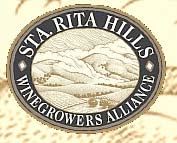 Sta. Rita Hills Winegrowers Alliance Open House & Passport Event “Holiday in the Hills” will be held December 3rd, 4th and 5th, 2010. Alliance members Cargasacchi, Ken Brown, Dierberg, Dragonette Cellars, Fiddlehead Cellars, Flying Goat, Gypsy Canyon, Jalama Wines, Loring Wine Company, Moretti Wines, Pali Wine Company, Prodigal and Zotovish, among others, will be participating in a complimentary Alliance passport event as their holiday gift to wine lovers. When five wineries are visited and the passport stamped, you will be entered in a drawing with winners eligible to purchase a mixed case of Sta. Rita Hills wines for a penny. For information and to download the passport, visit www.winecountryholiday.com.
The Bucket List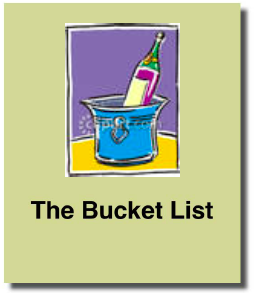 The following is a carefully prepared list of classic wines, many with a historic pedigree, that should be on every pinotphile’s bucket list of California Pinot Noirs to try before you, well, stop drinking. The Oregon Pinot Noir Bucket List will be in the next issue.
|